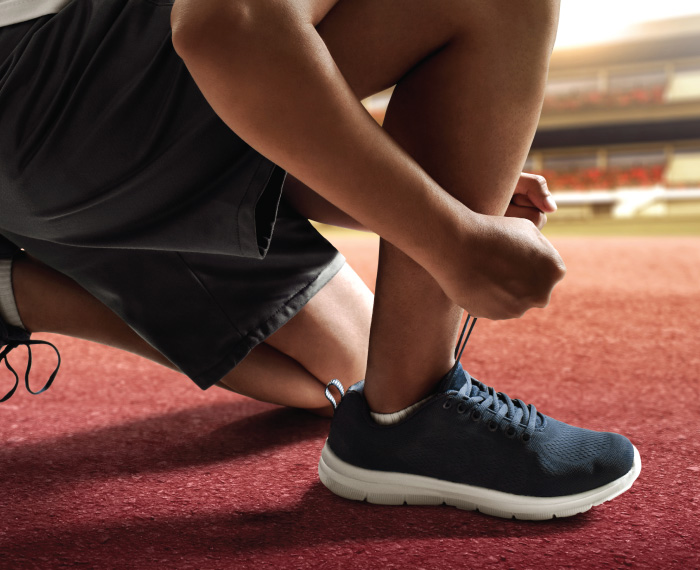
Athlete’s Foot
An athlete’s foot is a common fungal skin infection that affects the skin of the feet. In rare cases, the toenails or hands can be involved. Regardless of its presentation, it is quite common, and almost everyone experiences this infection once in their lifetime. The global prevalence of athlete’s foot is 3-15%. If you are also among the sufferers, don’t worry. Our expert podiatrists at 5 Boro Podiatry are here to guide you through everything related to this condition. In this blog, we will discuss what an athlete’s foot looks like and what is the strongest treatment for an athlete’s foot.
So, without further delay, let’s get into it.
Causes and Risk Factors
The main cause of an athlete’s foot is a special fungus growth known as dermatophytes. Such fungus needs a warm, damp environment for its optimum growth. Public showers, swimming pools, and locker rooms are just the right environment, allowing fungi to infect bare feet. The infection can also spread from contaminated socks, shoes, and towels.
Apart from that, several other risk factors that increase the risk of athlete’s foot infection are,
- Wearing non-breathable and tight footwear creates a damp environment favorable for the fungus to grow.
- Excessive sweating on the feet
- Minor skin or nail injuries on the feet
- Sharing of footwear, socks or towels with people who already have athlete’s foot boosts the spread of infection.
These risk factors demonstrate the fungus’s contagious nature, and thus, proper foot hygiene and cautious use of common facilities should be practiced so that the disease does not spread from person to person.
What Does Athlete’s Foot Look Like?
Athlete’s foot symptoms can vary from person to person. However, they generally involve a set of uncomfortable and visually noticeable changes in the feet. Therefore, your symptoms will help you decide what an athlete’s foot looks like.
The most common symptoms are,
- A peculiar sensation of itching, burning, or stingingthat worsens after you remove your socks and shoes.
- The infection can cause chronic drynessand scaling on the sole that extends up the side, resembling eczema or dry skin.
- A red, scaly rashmay appear, often accompanied by itching. This rash can spread to the instep of the foot and is particularly common in the spaces between the toes.
- In some cases, painful blistersand ulcers can develop, which may become infected if not treated properly.
- Few infected people can experience moccasin-type athlete’s foot. It is a special type that typically affects the toes and soles of the feet. The affected skin may thicken, crack, and even fall out.
These symptoms are not only uncomfortable but can also lead to more serious complications if left untreated. The infection can spread to other parts of the body, including the hands and nails, especially if the individual scratches or touches the infected area.
Achilles Tendinitis Treatment
If you have already contracted the infection, you are probably wondering what is the strongest treatment for an athlete’s foot to get rid of it once and for all. However, there is no simple answer to this question, as the choice of treatment depends on the severity and type of the athlete’s foot infection.
Here are some options for you.
Over-the-counter (OTC) Athlete’s Foot Medication
For mild cases of athlete’s foot, over-the-counter antifungal creams, powders, sprays, and lotions are often effective.
These products contain active ingredients such as terbinafine, clotrimazole, miconazole, or tolnaftate and are designed to kill the fungus causing the infection.
To ensure the fungus is eliminated, it’s essential to follow your podiatrist’s advice and continue the treatment for the recommended duration, even if the symptoms disappear sooner.
Prescription Athlete’s Foot Medications
If the athlete’s foot is severe or doesn’t respond to OTC treatments, our expert podiatrist at 5 Boro Podiatry may prescribe stronger topical antifungal medications or oral antifungal drugs.
Prescription topical treatments might include creams or ointments with a higher concentration of antifungal agents.
Oral antifungal medications, such as terbinafine or itraconazole, are used for cases where the infection has spread to a larger area or is particularly stubborn.
These medications can have side effects and may interact with other medications, so it’s important to discuss potential risks and benefits with an expert podiatrist.
Athlete’s Foot Self-Care
Certain home remedies can help alleviate symptoms and support the healing process in addition to medical treatments. For example, soaking the feet in salt water or vinegar solution can relieve itching and help dry out blisters. However, these remedies should be used in conjunction with, rather than as a replacement for, recommended athlete’s foot medication.
What is the strongest treatment for an athlete’s foot?
Athlete’s foot medications such as antifungal creams and oral antifungal drugs are the strongest treatment for athlete’s foot. However, the required dose of the medication can vary from person to person. Therefore, you should consult with our expert podiatrist at 5 Boro Podiatry for expert advice.
When should You see a doctor for an athlete’s foot?
We recommend that getting expert advice is always a good option regardless of the severity of your infection. Early detection and prompt treatment can save you from a lot of trouble that comes your way afterward.
However, for some reason, if you don’t get a chance to visit a podiatrist, and now your infection has worsened – your feet feel tender to touch, or there are signs of bacterial infection such as pus – you should immediately get expert advice.
Where to Find Expert Podiatrists?
At 5 Boro Podiatry, we understand the inconvenience and struggle of dealing with athlete’s foot symptoms. That’s why we’ve dedicated ourselves to offering the strongest treatment for athlete’s foot to help you get back on your feet with confidence and ease.
Your health is our top priority, and at 5 Boro Podiatry, you will witness how committed we are to making the change.
So, why the wait?
Visit our website to learn more about us, and book your appointment today.
